
Superstudio 2020 - awards
Magdalena Juřicová, Johana Krejčí, Ondřej Šašek
Path of Reconciliation
Our Path of Reconciliation highlights the memorial of a place that has been indelibly marked by the traces of historical events. Let us transport ourselves to the village of Svatobor in the Karlovy Vary region. Violence and oppression, 3 million German settlers expelled from the borderlands - this is a brief description of the situation that arose after World War II. The land was nationalized, and many foreigners, as well as Czechs and Slovaks, were forced to live in this place with a strong sense of alienation, guilt, and no connection to a place that, under duress, became their homeland.
This region is significantly different from others. It bears the traces of past events; over the years it has been affected by war, the displacement of Czechs, and the expulsion of Germans. It is a dark chapter in the nation's history, and even now, 70 years later, it remains an uncomfortable topic.
Repression, awareness, and forgiveness, as found in history, are inscribed into our proposal. We demonstrate them using the example of the Svatobor Church of the Assumption of the Virgin Mary, which is one of only two preserved churches in the Doupov Mountains area. It is deteriorating, and its collapse would lead to the irrevocable loss of cultural and historical heritage. The Association for the Documentation and Restoration of Monuments in Karlovy Vary initiates efforts to preserve it and to create a memorial for the vanished villages and the fates of the residents of the Doupov Mountains in its place.
We symbolize repression through a new object - a bubble - which tries to expand in all directions but encounters an insurmountable physical barrier. This draws an analogy to the history of the place, where new inhabitants attempted to displace the German settlers. Thus, the proposal reflects a noticeable tension between the old and the new.
We symbolize awareness through a path leading to forgiveness. Forgiveness that we seek and find within ourselves. The rectory located in close proximity to the church lost its original purpose with the departure of the Germans. The collapsed roof and trees growing inside gradually erase the boundary between interior and exterior. With this idea, we create a new skin along the periphery of the original walls, which preserves the original state while allowing for the reuse of the building. The old and new structures cannot exist one without the other. Although we use two different principles, two distinct types of skins, both have an inclusive character. The construction statically secures the object and simultaneously emphasizes the necessary cooperation and need for inclusion. One cannot exist without the other.
The interior space of the church becomes an exterior space for the newly inserted object – the new skin. Outside the bubble, we feel the anxiety of a confined space – to get closer means to endure a greater weight. Inside, we feel the strength that heals the wounds of the past.
We point to the presence of an artificially created psychological boundary, and with our intervention, we want to restore the general hospitality and sacredness of the place. The proposal brings a cultural impact on society as a whole and practical use of the deteriorating structures.
Our Path of Reconciliation highlights the memorial of a place that has been indelibly marked by the traces of historical events. Let us transport ourselves to the village of Svatobor in the Karlovy Vary region. Violence and oppression, 3 million German settlers expelled from the borderlands - this is a brief description of the situation that arose after World War II. The land was nationalized, and many foreigners, as well as Czechs and Slovaks, were forced to live in this place with a strong sense of alienation, guilt, and no connection to a place that, under duress, became their homeland.
This region is significantly different from others. It bears the traces of past events; over the years it has been affected by war, the displacement of Czechs, and the expulsion of Germans. It is a dark chapter in the nation's history, and even now, 70 years later, it remains an uncomfortable topic.
Repression, awareness, and forgiveness, as found in history, are inscribed into our proposal. We demonstrate them using the example of the Svatobor Church of the Assumption of the Virgin Mary, which is one of only two preserved churches in the Doupov Mountains area. It is deteriorating, and its collapse would lead to the irrevocable loss of cultural and historical heritage. The Association for the Documentation and Restoration of Monuments in Karlovy Vary initiates efforts to preserve it and to create a memorial for the vanished villages and the fates of the residents of the Doupov Mountains in its place.
We symbolize repression through a new object - a bubble - which tries to expand in all directions but encounters an insurmountable physical barrier. This draws an analogy to the history of the place, where new inhabitants attempted to displace the German settlers. Thus, the proposal reflects a noticeable tension between the old and the new.
We symbolize awareness through a path leading to forgiveness. Forgiveness that we seek and find within ourselves. The rectory located in close proximity to the church lost its original purpose with the departure of the Germans. The collapsed roof and trees growing inside gradually erase the boundary between interior and exterior. With this idea, we create a new skin along the periphery of the original walls, which preserves the original state while allowing for the reuse of the building. The old and new structures cannot exist one without the other. Although we use two different principles, two distinct types of skins, both have an inclusive character. The construction statically secures the object and simultaneously emphasizes the necessary cooperation and need for inclusion. One cannot exist without the other.
The interior space of the church becomes an exterior space for the newly inserted object – the new skin. Outside the bubble, we feel the anxiety of a confined space – to get closer means to endure a greater weight. Inside, we feel the strength that heals the wounds of the past.
We point to the presence of an artificially created psychological boundary, and with our intervention, we want to restore the general hospitality and sacredness of the place. The proposal brings a cultural impact on society as a whole and practical use of the deteriorating structures.
The English translation is powered by AI tool. Switch to Czech to view the original text source.
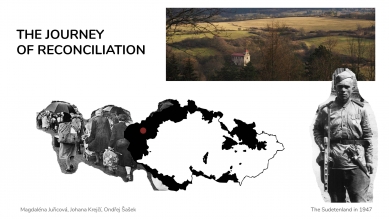
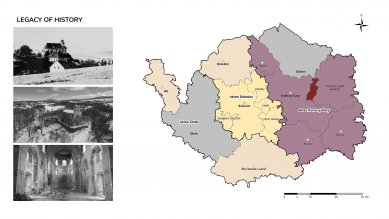
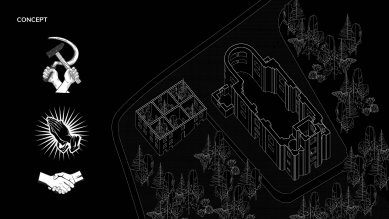
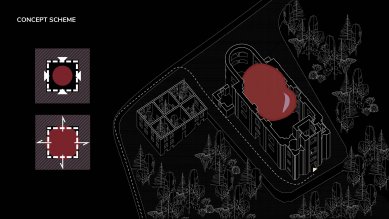
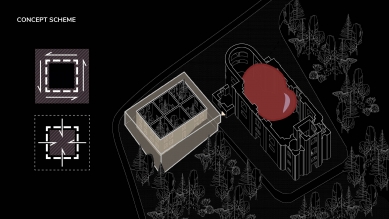
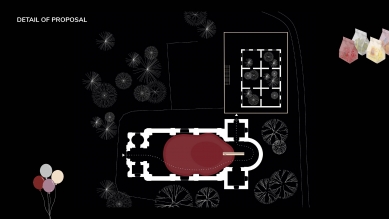
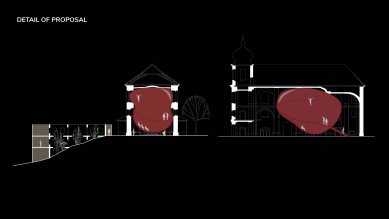
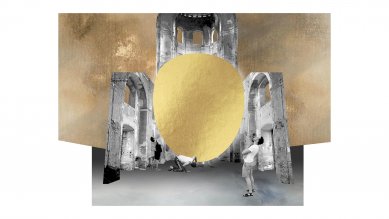
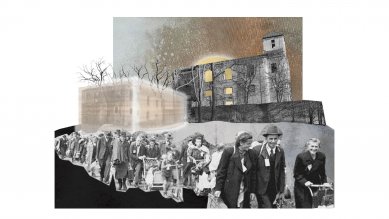
0 comments
add comment












